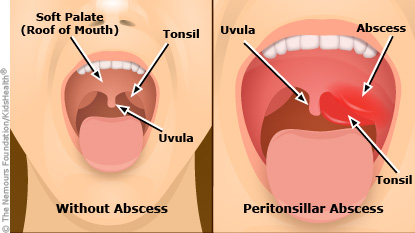- Parents Home
- Para Padres
- A to Z Dictionary
- Allergy Center
- Asthma
- Cancer
- Diabetes
- Diseases & Conditions
- Doctors & Hospitals
- Emotions & Behavior
- First Aid & Safety
- Flu (Influenza)
- Food Allergies
- General Health
- Growth & Development
- Heart Health & Conditions
- Homework Help Center
- Infections
- Newborn Care
- Nutrition & Fitness
- Play & Learn
- Pregnancy Center
- Preventing Premature Birth
- Q&A
- School & Family Life
- Sports Medicine
- Teens Home
- Para Adolescentes
- Asthma
- Be Your Best Self
- Body & Skin Care
- Cancer
- Diabetes
- Diseases & Conditions
- Drugs & Alcohol
- Flu (Influenza)
- Homework Help
- Infections
- Managing Your Weight
- Medical Care 101
- Mental Health
- Nutrition & Fitness
- Q&A
- Safety & First Aid
- School, Jobs, & Friends
- Sexual Health
- Sports Medicine
- Stress & Coping
Peritonsillar Abscess
What's a Peritonsillar Abscess?
A peritonsillar abscess is an area of pus-filled tissue at the back of the mouth, next to one of the tonsils. The abscess can be very painful and can make it hard to open the mouth.
It can also cause swelling that can push the tonsil toward the uvula (the dangling fleshy object at the back of the mouth). This can block the throat, making it hard to swallow, speak, and sometimes even breathe.
If you think you have an abscess in the back of your throat, you need to see a doctor. A peritonsillar abscess that isn't treated can lead to more serious health problems.
What Causes Peritonsillar Abscesses?
Most peritonsillar abscesses are caused by the same bacteria that cause strep throat. Sometimes, other types of bacteria are involved.
Peritonsillar abscesses usually happen as a complication of tonsillitis. If the infection breaks out of a tonsil and gets into the space around it, an abscess can form. Luckily, peritonsillar abscesses aren't that common these days because doctors use antibiotics to treat tonsillitis.
Gum disease and smoking can increase a person's chances of developing an abscess.
What Are the Signs of a Peritonsillar Abscess?
Often, the first sign of a peritonsillar abscess is a sore throat. As the abscess develops, other symptoms start, such as:
- red, swollen tonsils
- tender, swollen glands (lymph nodes) on one side of the neck
- severe pain on one side of the throat
- difficulty and pain when swallowing or opening the mouth
- fever and chills
- headache
- earache
- drooling
- a muffled or hoarse voice
- bad breath
An abscess that's not treated quickly can lead to serious problems — for example, the infection may go into the jaw and neck. If the abscess pops, the infection may spread to the chest and lead to pneumonia.

How Is a Peritonsillar Abscess Diagnosed?
Call your doctor if you have a sore throat with a fever or any of the other problems that can be caused by a peritonsillar abscess. It's rare that an abscess will get in the way of your breathing, but if it does, you may need to go to the emergency room right away.
The doctor will examine your mouth, throat, and neck. They will look for an extremely swollen red area around the tonsil that pushes against the uvula. They also may take a throat culture and a blood test. On rare occasions, a doctor may order a CT scan or ultrasound.
How Is a Peritonsillar Abscess Treated?
The usual treatment for a peritonsillar abscess involves having a doctor drain the abscess. The doctor does this either by withdrawing the pus with a needle (called aspiration) or making a small cut in the abscess with a scalpel so the pus can drain out.
If this doesn't work, a patient's tonsils might have to be removed in a procedure called a tonsillectomy. This is especially true for people who have had tonsillitis a lot or who have had a peritonsillar abscess in the past.
If it's hard to eat or drink, patients may need IV (intravenous, given into a vein) fluids for hydration. A doctor also will prescribe painkillers and antibiotics. Whenever you take antibiotics, always finish them as prescribed, even if you feel better after a few days. Otherwise, the infection could come back.
People who have a tonsillectomy may need a brief stay in the hospital. That way, doctors can keep an eye on them to make sure everything went as planned.
Can Peritonsillar Abscesses Be Prevented?
To lower your risk of getting an abscess in your tonsils, don't smoke and make sure you keep your teeth and mouth clean.
But sometimes a peritonsillar abscess is beyond your control. If you think you have an abscess, call your doctor right away. The earlier a doctor diagnoses it, the easier treatment will be.

© 1995- The Nemours Foundation. KidsHealth® is a registered trademark of The Nemours Foundation. All rights reserved.
Images sourced by The Nemours Foundation and Getty Images.